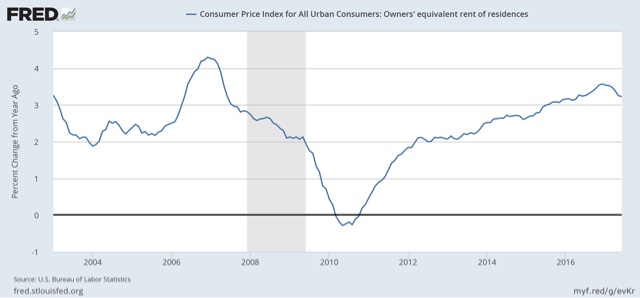Apartment vacancy rate improves, but “rental affordability crisis” at worst level ever Over three years ago HUD warned of “the worst rental affordability crisis ever,” citing statistics that About half of renters spend more than 30 percent of their income on rent, up from 18 percent a decade ago, according to newly released research by Harvard’s Joint Center for Housing Studies. Twenty-seven percent of renters are paying more than half of their income on rent. This is a serious real-world issue. I have been tracking rental vacancies, construction, and rents ever since. The Q2 2017 report on vacancies and rents was released last week, so let’s take an updated look. After stopping for a year, in the second quarter median asking rents zoomed up over 5% from
Topics:
NewDealdemocrat considers the following as important: Taxes/regulation, US/Global Economics
This could be interesting, too:
Joel Eissenberg writes How Tesla makes money
Angry Bear writes True pricing: effects on competition
Angry Bear writes The paradox of economic competition
Angry Bear writes USMAC Exempts Certain Items Coming out of Mexico and Canada
Apartment vacancy rate improves, but “rental affordability crisis” at worst level ever
Over three years ago HUD warned of “the worst rental affordability crisis ever,” citing statistics that
About half of renters spend more than 30 percent of their income on rent, up from 18 percent a decade ago, according to newly released research by Harvard’s Joint Center for Housing Studies. Twenty-seven percent of renters are paying more than half of their income on rent.
This is a serious real-world issue. I have been tracking rental vacancies, construction, and rents ever since. The Q2 2017 report on vacancies and rents was released last week, so let’s take an updated look.
After stopping for a year, in the second quarter median asking rents zoomed up over 5% from $864 to $910. Meanwhile, surprisingly weekly wages declined from $865 to $859.. The combined effect is that rent has become more unaffordable than ever.
The big jump in median asking rents in the second quarter can be easily seen in the below graph:
Here is an updated look at real. inflation adjusted median asking rents, showing that after abating a bit for a year after Q1 2016, rent pressures on household budgets spiked in the second quarter:
The big increase in unaffordability is a nasty surprise, eespecially since the vacancy rate appears to have bottomed over a year ago, so while apartment availability is still relatively tight, the level of stress has decreased a little:
It is worthwhile to note that the CPI for owner’s equivalent rent, the major component of inflation, remains near the highest levels in a decade, although it has backed off a little this year:
There are two other median measures in addition to median asking rent from the HVS: the American Community Survey and the Consumer Expenditure Survey. Unfortunately both are only current through 2015. The below table shows their YoY increases, compared with median asking rent:
SURVEY: ACS CES HVS
2009 ——– (817) ——- —— (708)
2010 +2.9% (841) +1.4% +2.6% (698)
2011 +3.6% (871) +4.4% -0.6% (694)
2012 +2.1% (889) +5.2% +3.3% (717)
2013. +1.7% (904) +4.7% +2.4% (734)
2014 +1.8% (920) +9.2% +3.8% (762)
2015 +0.9% (928) +4.3%* +6.7% (813)
Finally , HUD recently premiered a Rental Affordability Index,, using the ACS data. Similar to my chart above, it compares median renter income with median asking rent. Please note, however, that this has only been updated through Q1 of this year:
Like the median household income data, this shows renters’ income bottoming out in 2011-12, and rising since relative to rents as calculated by the ACS.
That gives us the “renatl affordability index” shown below:
.
I’m not sold on HUD’s method, mainly because it relies upon annual data released with a lag. In other words, the entire last year plus is calculated via extrapolation. I suspect we could get much more timely estimates using Sentier’s monthly median household income series, compared with the monthly rental index calculated by Zumper. It will be interesting to see if HUD confirms the Homeowner Vacancy Survey’s jump in UNaffordability when it releases its Q2 data soemtime later this quarter.
The takeaway from this quarter’s report is that, while the crunch in vacancies has probably passed peak, the “rental affordability crisis,” which had appeared to be abating at least a little, has come back with a vengeance.






